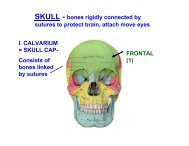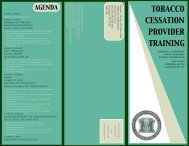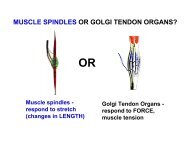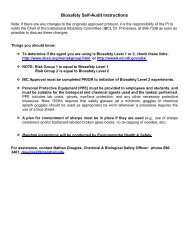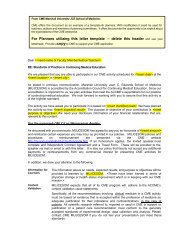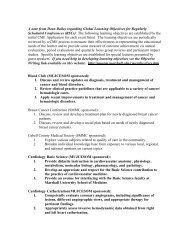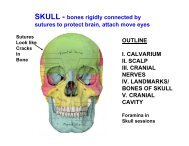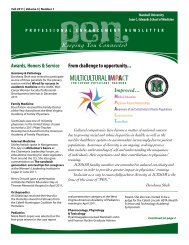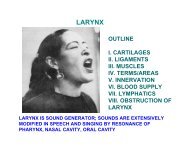FA 5 Progress Report WV-INBRE - Joan C. Edwards School of ...
FA 5 Progress Report WV-INBRE - Joan C. Edwards School of ...
FA 5 Progress Report WV-INBRE - Joan C. Edwards School of ...
- No tags were found...
Create successful ePaper yourself
Turn your PDF publications into a flip-book with our unique Google optimized e-Paper software.
Program Director/Principal Investigator (Last, First, Middle): Rankin, Gary O 29running in the Amazon Web Services cloud computing system.Results and DiscussionApproximately 135 million paired-end reads were obtained from the successful sequencing run. Postsequencing data processing has involved de-multiplexing the sequences and assigning thesequences to the correct sample identifier. Next, the paired end reads were processed to join the 2ends at overlapping regions <strong>of</strong> high quality sequences (Q score 30 or greater), and extraneoussequences used for multiplexing and sequencing were removed, yielding analyzable sequences <strong>of</strong>~160 bases. About 30% <strong>of</strong> the starting data set successfully passed through quality filtering andare currently being processed by QIIME. Preliminary analysis <strong>of</strong> a subset <strong>of</strong> high-quality processedsequences indicates that the sequencing and data analysis pipeline is a success. Each studysample is providing a ‘microbial signature’ that is consistent with oral bacteria, and differences inmicrobial populations within individual samples make it possible to predict whether the sample wasobtained from ‘healthy’ or ‘diseased’ sites, i.e. high numbers <strong>of</strong> sequences corresponding todisease-associated ‘red complex’ bacteria such as Prevotella sp. and Porphyromonas sp., as wellas Treponemes can be detected some but not all samples. Ongoing work will center oncompleting the analysis and then linking these findings to other parameters <strong>of</strong> oral health andcognitive function to determine whether a distinct microbial signature is predictive <strong>of</strong> decreasedcognitive function.NGS Project #2Title: Epigenetic Modulations <strong>of</strong> Breast Cancer by Omega-3 Fatty Acids Mediated By Changes inHistone Post-Translational Modifications.Subproject investigators: Philippe Georgel PhD and Elaine Hardman PhDIntroduction: The goal <strong>of</strong> the proposed research was to identify breast cancer-related genesepigenetically regulated through changes in histone post-translational modifications (PTM) involvedin imprinting events mediated by omega-3 fatty acid diet. Our preliminary work has identified twohistone PTM, H3K18 acetylation (H3K18ac) and H3K4 di-methylation (H3K4me2) as globallymodulated in breast tissue <strong>of</strong> the <strong>of</strong>fspring <strong>of</strong> mice whose maternal diet was rich in omega-3 fattyacids. Our original transgenic mouse model linked that increased H3K18ac and H3K4me2 wasassociated with a reduced susceptibility to breast cancer. Our preliminary gene expression pr<strong>of</strong>ilingexperiments revealed that a fairly large number <strong>of</strong> genes were differentially expressed in mice as afunction <strong>of</strong> diet (omega-3 vs. an omega-6 <strong>FA</strong>-rich diet). To investigate the epigenetic role <strong>of</strong>H3K18ac and H3K4me2 on preventing breast cancer (BCa) in response to different <strong>FA</strong> diets, weplanned to perform a chromatin immuno-precipitation experiments, using anti H3K18ac and antiH3K4me2 antibodies followed by genome-wide sequencing <strong>of</strong> MeCP2-associated fragments toidentify all targeted genes whose expression level is dependent on changes in the histone PTMsabove-listed.Specific aims: To investigate the genetic location susceptible to changes in H3K18ac andH3K4me2 in BCa cells isolated from mammary glands <strong>of</strong> F1 generation mice fed with a corn oil(CO) diet whose mother consumed using either a canola oil (CA) or CO-based diet [CO (maternaldiet)/CO (<strong>of</strong>fspring diet] vs. CA/CO diets during gestation and lactation <strong>of</strong> the F1 mice, weproposed the two following Specific Aims:Specific Aim 1: Generation <strong>of</strong> a genome-wide map <strong>of</strong> H3K18ac and H3K4me2-interactingsequences by chromatin immunoprecipitation followed by deep sequencing (ChIP-Seq). SpecificAim 2: Match genetic loci affected by H3K18ac and H3K4me2 to the genes which expressionhas been shown to be modulated by maternal diet changes from CO-CO to CO-CA.Methods: 1. Generation <strong>of</strong> genome-wide K3K18ac and H3K4me2 maps: To confirm that specificPHS 2590 (Rev. 06/09)Continuation Format Page



